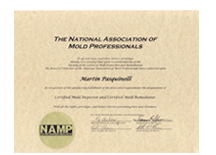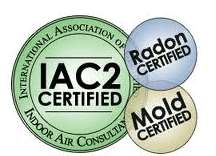Indoor Air Quality Concerns
Are you concerned about the quality of the air you breathe in your home or office?
All of us face a variety of risks to our health as we go about our day-to-day lives. Indoor air pollution is one risk that you can do something about.
Mold and Allergens
These biological chemicals can arise from a host of means, but there are two common classes: (a) moisture induced growth of mold colonies and (b) natural substances released into the air such as animal dander and plant pollen. Moisture buildup inside buildings may arise from water penetrating the interior, plumbing leaks, condensation due to improper ventilation, or from ground moisture penetrating a building.
In areas where cellulosic materials (paper and wood, including drywall) become moist and fail to dry within 48 hours, mold can grow and release allergenic spores into the air.
If materials have failed to dry out several days after the water event, mold growth is probable on visible and non-visible areas such as wall cavities. Through comprehensive air testing, we can determine the presence or absence of mold.
In a situation where there is visible mold and the indoor air quality may have been compromised, mold remediation may be needed. Click here (link to mold page) for info on mold abatement
How Structure & Site Conducts Air Quality Testing
Indoor air quality testing comprises of collecting 75 liters of air in a given area of the home or building. Multiple tests are taken throughout the property in order to determine an air quality profile.
What We're Looking For
High level allergens like mold, pollen, dander and fibrous particulate exist in every enclosed environment - the quantity of these allergens is the most important factor.
Our Testing Is Unique
Each of the samples taken from your property is analyzed for the following high-level allergens:
- Mold Spores
- Toxic Mold Strains
- Dander
- Pollen
- Fibrous Particulate
We utilize state-of-the-art air impaction equipment and send all samples to an independent, certified laboratory for analysis. The cost for our complete air testing is less than what others charge for only one of the high-level allergens listed above.
Radon Gas
Radon is an invisible, radioactive atomic gas that results from the radioactive decay of radium, which is found in rock and soil beneath buildings or in certain building materials themselves.
Radon is probably the most pervasive serious hazard for indoor air in the United States, and according to the EPA, is responsible for tens of thousands of deaths from lung cancer each year.
Radon is a heavy gas and thus will tend to accumulate at the lowest level in the building.
Every building has radon accumulation. The EPA has a definitive action level that highly suggests remediation if your building is at or above this level of radon gas concentration. Only testing can determine your radon gas level.
How Structure & Site Tests for Radon
To ensure accurate measurements of the radon level in your home or building, we EPA approved and recommended collection equipment.
Two collection units are utilized to ensure that the test is accurate. The minimum testing time is 48 h
ours.Upon completion of the testing, an easy to read report is generated with your radon number prominently highlighted.
Who Should Test
There are two reasons to test for radon gas:
Health - lung cancer sucks. Children are especially vulnerable.
Liability - Thousands of law suits are filed each year in the U.S. over radon. Landlords, home owners, business owners and property managers are all vulnerable to lawsuits if occupants become sick over high radon levels in your building.
Testing is cheap and easy.
Carbon Monoxide
One of the most acutely toxic indoor air contaminants is carbon monoxide (CO), a colorless, odorless gas that is a byproduct of incomplete combustion of fossil fuels. Common sources of carbon monoxide are tobacco smoke, space heaters using fossil fuels, defective central heating furnaces and automobile exhaust.
By depriving the brain of oxygen, high levels of carbon monoxide can lead to nausea, unconsciousness and death. You should install multiple carbon monoxide detectors within your home or building.
VOC's
Volatile organic compounds (VOCs) are emitted as gases from certain solids or liquids. VOCs include a variety of chemicals, some of which may have short- and long-term adverse health effects. Concentrations of many VOCs are consistently higher indoors (up to ten times higher) than outdoors.
VOCs are emitted by a wide array of products numbering in the thousands. Examples include: paints and lacquers, paint strippers, cleaning supplies, pesticides, building materials and furnishings, office equipment such as copiers and printers, correction fluids and carbonless copy paper, graphics and craft materials including glues and adhesives, permanent markers, and photographic solutions.
Organic chemicals are widely used as ingredients in household products. Paints, varnishes, and wax all contain organic solvents, as do many cleaning, disinfecting, cosmetic, degreasing, and hobby products. Get rid of those paint cans in your basement.
Fuels are made up of organic chemicals. All of these products can release organic compounds during usage, and, to some degree, when they are stored. Don't store fuels inside a building.
Effect Of Indoor Plants
Houseplants together with the medium in which they are grown can reduce components of indoor air pollution, particularly volatile organic compounds (VOC) such as benzene, toluene, and xylene. The compounds are removed primarily by soil microorganisms. Plants can also remove CO2, which is correlated with lower work performance, from indoor areas.
Clean Green
Green cleaning is a term that describes a growing trend in favor of using cleaning methods with environmentally-friendly ingredients and chemicals to preserve human health and environmental quality.
Green cleaning techniques and products avoid the use of chemically-reactive and toxic cleaning products which contain various toxic chemicals, some of which emit volatile organic compounds (VOCs) causing respiratory and dermatological problems among other adverse effects. Green cleaning can also describe the way residential and industrial cleaning products are manufactured, packaged and distributed. If the manufacturing process is environmentally-friendly and the products are biodegradable, then the term "green" or "eco-friendly" may apply
Natural cleaning products are substances used to clean, deodorize, and/or disinfect which have natural substances as their active ingredients. In some cases, natural cleaning products may be less damaging to the environment and safer for humans and pets than conventional cleaning products.
Effective natural cleaning products can be made from combing common household ingredients, such as:
- Lemon juice
- Borax
- Vinegar
- Salt
- Mineral oil
- Baking soda
- Washing soda
- Vegetable based soap






